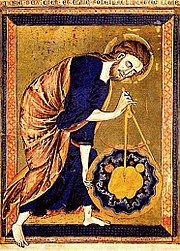Lectures related to book arts or poetry
Monday, April 27, 7:15 p.m.
Jeffrey Hamburger, “Openings”
We forget how the bound book's basic visual unit, two pages that face one another, shaped our perception of books. Imagine the striking contrast of the bound book that originated in Late Antiquity to the scrolls used in the ancient world. When a medieval book was opened at any point, the verso of one leaf confronted the recto of the following leaf. The innovation created a new medium - a visual field for scribes and artists. Openings made possible visual elaboration of words, frames, and full-page miniatures. This lecture explores the semantics and revelatory possibilities this new medium as it developed from the fifth to the fifteenth century.Tuesday, April 28, 5:15 p.m.
Jeffrey Hamburger, “As It Were’: Mysticism and Visuality‘
By definition, the ineffable lies beyond visual or verbal representation. The word “mysticism” comes from the Greek myein, “to remain silent” or “to close the lips or eyes.” What place can there be for the visible in a system of thought predicated on obscurity and blindness? Extending the paradox: were mystics to fall silent, there would not be any mystical literature. Yet a discourse that by definition shuns the senses was carried via those same senses. Although controversial, mysticism’s sensory and, at times, sensual side was integrated into the spiritual. Illusionistic strategies made images more persuasive, changing attitudes towards works of art. Not even the Reformation could undo this affirmation of the visual.

Bible Moralisée
Katherine Tachau, “Illuminating the Science of the Stars in the Thirteenth-Century Bibles Moralisées”
Bibles Moralisées, first produced in the thirteenth century for members of the French royal family, are extensively and sumptuously illustrated manuscripts, each containing thousands of pictures. By contrast, they contain a relatively small amount of text that paraphrases actual Old and New Testament text.
Dante Alighieri, exiled from Florence,
holding a copy of the Commedia
Wednesday, April 29, 7:15 p.m. holding a copy of the Commedia
Christopher Kleinhenz, “Dante’s Vision of the Afterlife”
In this lecture on the supreme masterpiece of medieval literature, Christopher Kleinhenz will first discuss the various sorts of “visions” and “ways of seeing” present in the medieval world before looking specifically at Dante’s representation of the afterlife in the Divine Comedy. He will examine the afterlife both as a real and traversable place/space and as a moral and spiritual construct. He will also consider the meaning and functionality of the afterlife in Dante’s Comedy, examining in particular how the poem represents the operation of Divine Justice through the nature of the punishments in the Inferno, the purgation process in Purgatory, and the concept of beatitude in Paradise. The lecture will include discussion of the artistic sources of Dante’s rich poetic language and imagery, and of the rich illustrative tradition that his poem generated in manuscript illuminations and book illustrations. The lecture will be accompanied by many fine visual images.


No comments:
Post a Comment